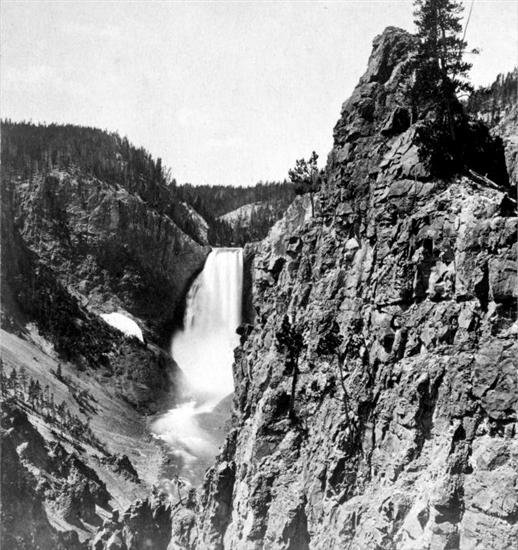Vintage Images
Lower Falls of Yellowstone

Stereograph showing canyon and waterfalls.
by Joshua Crissman
Published by W.I. Marshall, c1876.
Fitchburg, Mass.
ext from back of stereograph:
The National Park
This Park, the largest in the world, area 3578 sq, miles, elevation above the sea from 6000 to 14,000 ft., is on both sides (but mainly on E. side) of the main range of the Rocky Mts., in N. W. corner of Wyoming Territory. U. S. of A. It was made a National Park by Act of Congress, approved March 1, 1872, and contains a far greater number and variety of natural wonders – lakes, cataracts, cañons, mud volcanoes. solfataras, fumaroles, ornamental hot springs, spouting geysers, etc., – than any other equal area on the globe.
----------------
YELLOWSTONE FALLS AND GRAND CAÑON SERIES.
Subject Underlined.
Nos. 63. 64. Upper Fails of Yellowstone, 140 ft. high.
" 65, 66. Crystal Cascades of Cascade Creek, 129 feet high.
" 67,68, 69. Lower Falls of Yellowstone, 397 ft. high
" 70, 71, 72, 73. Grand Cañon of Yellowstone, 12 to 1500 ft. deep.
The Yellowstone River (Yellowstone River Series, Nos. 56 to. 73 inclusive), 20 miles N. of Yellowstone Lake (see Yellowstone Lake Series, Nos. 53 to 55 inclusive), and 13 miles N. of Mud Volcanoes (see Nos. 51 and 52), after dashing down the Yellowstone Rapids, leaps down the Upper Falls, and a short ½ mile below down the Lower Falls, receiving, about midway between the two, Cascade Creek from the W. The colored part of the Grand Cañon begins between the two falls, and it is beyond question the loveliest rock scenery in the world. The-entire 27 miles in length of the Grand Cañon is through volcanic rocks which have weathered in countless quaint and lovely forms. The height and the curious erosions of the cliffs are, however, far less wonderful than the unequalled richness and variety of their coloring, comprising the whole range of the chromatic scale, except the pure blues and the blue greens and purples. Acres of yellow, from gold to pale straw; of red, from carmine to pink; of browns, and whites, and grays, and drabs, and blacks — all intermingled and blended, so that one sees all the rainbow-hued glories of the autumn woods dyed through and through these mighty cliffs; not evanescent, but eternal as the everlasting hills they buttress; not to vanish with the breath of winter, but to remain, to dazzle all beholders with their bewildering beauty, till autumns cease, and winters come no more. 20 miles below the Falls of the Yellowstone are Tower Falls, on Tower Creek (see Nos. 74 to 78); and 20 miles farther N. are the Mammoth Hot Springs (see Nos. 89 to 116), on Gardiner's River (see Nos. 79 to 88).
Library of Congress image: http://hdl.loc.gov/loc.pnp/ppmsca.09581
Photo album created with Web Album Generator